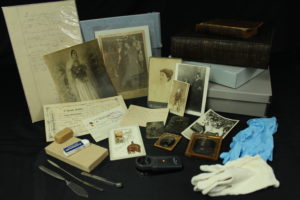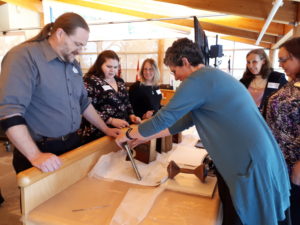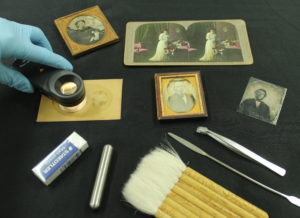Workshops
Interested in learning how to preserve your treasures, slowing deterioration and preventing damage? Would you like to learn more about identifying, dating, and authenticating works on paper and photographs? Have our knowledgeable staff deliver a 1-hour workshop or presentation for your community group or organization.
Want more information, demonstrations and hands on experiences? Organize a group of people for a 3 hour or full day training session. Prepackaged workshops start at $450.00. Great as a fund-raiser! Excellent training for heritage volunteers!
Contact Us to book a Zoom Presentation with Video Demonstrations
Up Coming Workshops and Presentations
March 26th, 6:30-8:30 – “Archival Preservation 101”; Hosted by Everyone Archives, Bethall Field House St. Luke’s Park at 166 Frank Street EVENTS (everyonearchives.ca)
This workshop explores methods of applying archival preservation in a home or office setting. Documents, photographs, clippings, works of art, diaries, and trinkets are the physical evidence that tell our stories. Knowing how to preserve them is crucial to ensuring the longevity of these pieces of cultural history. Learn about current practices for storing archival materials, how to detect processes of deterioration, and methods of intervention in this free workshop.
April 20th, 2024, 1pm – “Restorations of Biblical Proportions”; Presented for the Ottawa Branch of the OGS, 1pm 100 Tallwood, Ottawa and on Zoom Events – Ottawa Branch – OGS
Take a journey through the evolution of the English bible to the creation of the family bible, through binding and printing history, to how these books deteriorate and what a conservator does to restore the bindings and ensure their continued longevity.
May 4th, 2024, 10am – “Dating and Preserving Family Photographs”; Presented for Halton Hills Public Library – Zoom Preserving Family Photographs – Genealogy Circle (hhpl.ca)
A photograph tells a thousand tales, but only if its subject matter can be identified, and it has been given the chance at surviving the rigors of time and use. The first part of this presentation will take you through a brief history of photographic processes with a focus on dating images based on clothing, styles, and trends. The second part will provide tips and tricks for storing and caring for your photographs, ensuring their longevity.
July 21st, 2024 10:30 – “Dating and Preserving Family Photographs”; Hosted by Middleville Museum 2130 Concession 6D, Middleville (Lanark), Ontario, K0G 1K0 Events – MIDDLEVILLE AND DISTRICT MUSEUM (middlevillemuseum.org)
A photograph tells a thousand tales, but only if its subject matter can be identified, and it has been given the chance at surviving the rigors of time and use. The first part of this presentation will take you through a brief history of photographic processes with a focus on dating images based on clothing, styles, and trends. The second part will provide tips and tricks for storing and caring for your photographs, ensuring their longevity.
July 21st, 2024, 1-4pm – “A Snap in Time, A Shot for the Future: Preserving Your Family Photographs” ; Hosted By Middleville Museum 2130 Concession 6D, Middleville (Lanark), Ontario, K0G 1K0 Events – MIDDLEVILLE AND DISTRICT MUSEUM (middlevillemuseum.org)
If a picture says a thousand words, then a family photograph tells a thousand tales; and ones we want to pass on and keep for the future. Explore what agents of deterioration are causing damage to photographs and what can be done at home and in small institutions to mitigate and preserve them for the future. Proper boxing and albums, controlling the climate, keeping pollutants at bay, handling techniques, digitization and framing are all important to the longevity of your collection. Try out some of the techniques in class and go home with a simple acid-free folder. Make the most out of your resources with tips to preserve, digitize, use and ensure the longevity of your family’s pictorial history.
Workshop and Presentation Topics
 Stop the deterioration of your family’s historic documents, letters, photographs, albums, clippings, books, memorabilia and scrapbooks through the practice of archival preservation. Discuss simple and practical techniques that can be applied in a home setting. Learn how to avoid damage caused by pollutants, poor climate, light, pests, and mould through proper boxing, housing and storage. Acquire safe handling techniques, explore digitization options, and gain knowledge in regular maintenance and basic treatments that you can apply at home. Demonstrations in cleaning books and paper, removing clips and staples, separating photographs from ‘sticky’ album pages, and how to make simple acid-free folders with the opportunity to try these techniques, will provide you with the skills needed to start saving your family archives now.
Stop the deterioration of your family’s historic documents, letters, photographs, albums, clippings, books, memorabilia and scrapbooks through the practice of archival preservation. Discuss simple and practical techniques that can be applied in a home setting. Learn how to avoid damage caused by pollutants, poor climate, light, pests, and mould through proper boxing, housing and storage. Acquire safe handling techniques, explore digitization options, and gain knowledge in regular maintenance and basic treatments that you can apply at home. Demonstrations in cleaning books and paper, removing clips and staples, separating photographs from ‘sticky’ album pages, and how to make simple acid-free folders with the opportunity to try these techniques, will provide you with the skills needed to start saving your family archives now.
If a picture says a thousand words, then a family photograph tells a thousand tales; and ones we want to pass on and keep for the future. Knowing the photographic processes used to create an image helps identify the era the picture was taken in, and guides us in how to go about handling, using and preserving that image. From Daguerrotypes, and Tin types, to Colodial-Chloride, and Gelatin, and every photographic technique and emulsion type in between; learn how these process work, what time periods they were popular in, and how to identify them through practice with actual historic examples.
Explore what agents of deterioration cause damage to photographs and what can be done at home to mitigate and preserve them for the future. Proper boxing and albums, controlling the climate, keeping pollutants at bay, handling techniques, digitization and framing are all important to the longevity of your collection. Try out some of the techniques in class and go home with a simple acid-free folder. Make the most out of your resources with tips to preserve, digitize, use and ensure the longevity of your family’s pictorial history.
Mitigating deterioration requires the practice and implementation of climate control, pollutant reduction, appropriate storage techniques, and proper handling and use. Learn practical tips on how to detect problems and act to resolve issues that may occur in storage or during collection use. Hands on activities can include making a simple enclosure, among other basic cleaning techniques. Half day workshop focuses on one or two specific artifact types such as archival materials, audio video materials, organic or inorganic object and a full day can cover the basics of preserving multiple artifact collection types.
Assessing a collection and
storage facility to find and monitor potential agents of deterioration is paramount to preparing a plan for the long term care of your collections. The workshop will cover how to inspect the facility, conduct collection surveys and analysis that data to prioritize and allocate resources to best suit your collections needs for long term preservation. Group activities and participation exercises are utilized to provide a practical experience. Half day or full day. The half day workshop is a great combination with a half day on general preservation.
Find a balance between preservation and promotion of your collection through displays. How to reduce damage due to light exposure, climate fluctuations, pollutants, theft and vandalism, and improper mounting techniques are among the topics covered and explored during this workshop. Hands on activities can include making a simple or a complex book mount. Half day to full day, depending on type of mount being made.
Identifying and responding to mould and pest infestations quickly can mean the difference between a minor problem and a major infestation. From identifying the types of pest and mould, to monitoring for signs of potential infestations, to protecting your own health, and even how to remediate and kill mould and pests, this workshop provides the skills and knowledge to respond to this common problem. Hands on activities can includes viewing samples potentially taken from the collection itself, or from other sources. Half day, a great combination with a half day workshop on general preservation of preservation planning.
Being prepared for a disaster and knowing how to salvage artifacts quickly can save a collection for complete destruction. Pin pointing and minimizing risks, preparing and communicating a plan of action, and knowing how to respond is outlined to get you on your way to developing an Emergency Preparedness Plan. Half day or full day, a half day workshop in disaster planning is well pared with a half day workshop in dealing with pest and mould infestations. 
As a collections custodian in any capacity it is practical to have the skills which enable one to fully examine and identify all of the facets of paper based collections including written documents, signatures, works of art, fine art prints, and maps. Learning how to inspect these materials and discern the characteristics of specific inks and media, stylus’ use, printing techniques, paper fibers, animal skins and other substrates, provides the ability not only to authenticate works on paper but to further an understanding of the story they tell and enable one to predict preservation issues. Working with actual examples of works on paper and parchment, participants learn to use several tools and techniques to distinguish media types, manufacturing methods, and to apply that knowledge to dating, authenticating and enriching the story of the artifact. Half day or full day workshop.

Sleuth out the ancestors in your family albums by learning about photographic processes, fashion history, and trends of the past. If a picture says a thousand words, then a family photograph tells a thousand tales; and ones we want to pass on and keep for the future. Knowing the photographic processes used to create an image helps identify the era the picture was taken in, and guides us in how to go about handling,
using and preserving that image. From Daguerrotypes, and Tin types, to Colodial-Chloride and Gelatin, and almost every photographic technique and emulsion type in between; you will learn the basics of how these photographs were created, what time periods they were popular in, and how to identify and date them


 Stop the deterioration of your family’s historic documents, letters, photographs, albums, clippings, books, memorabilia and scrapbooks through the practice of archival preservation. Discuss simple and practical techniques that can be applied in a home setting. Learn how to avoid damage caused by pollutants, poor climate, light, pests, and mould through proper boxing, housing and storage. Acquire safe handling techniques, explore digitization options, and gain knowledge in regular maintenance and basic treatments that you can apply at home. Demonstrations in cleaning books and paper, removing clips and staples, separating photographs from ‘sticky’ album pages, and how to make simple acid-free folders with the opportunity to try these techniques, will provide you with the skills needed to start saving your family archives now.
Stop the deterioration of your family’s historic documents, letters, photographs, albums, clippings, books, memorabilia and scrapbooks through the practice of archival preservation. Discuss simple and practical techniques that can be applied in a home setting. Learn how to avoid damage caused by pollutants, poor climate, light, pests, and mould through proper boxing, housing and storage. Acquire safe handling techniques, explore digitization options, and gain knowledge in regular maintenance and basic treatments that you can apply at home. Demonstrations in cleaning books and paper, removing clips and staples, separating photographs from ‘sticky’ album pages, and how to make simple acid-free folders with the opportunity to try these techniques, will provide you with the skills needed to start saving your family archives now.
